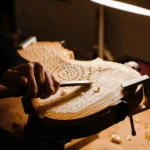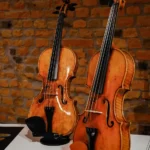Exploring Vuillaume Violins
Back to BlogExploring Vuillaume Violins: History, Craftsmanship, and Pricing
Jean Baptiste Vuillaume was a renowned and prolific maker of fine violins and an extremely successful dealer, connoisseur, and inventor. His workshop in Paris employed and trained some of the finest 19th-century violin and bow makers. In this blog, we will explore his incredible violins, delving into their history, excellent craftsmanship, and what to expect in pricing.
Jean Baptiste Vuillaume (1798 – 1875)
Jean Baptiste Vuillaume is the decisive figure in modern French violin making. He is undoubtedly the most successful violin maker of the 19th century, and, in pure business terms, he probably ranks as the greatest luthier in all history. His excellence lies in the quality of his work, his creative and innovative strengths, and his enormous business acumen. From a traditional violin-making background in Mirecourt, he built a virtual empire in Paris, and his influence can still be felt in all aspects of the craft and trade of stringed instruments.
Jean Baptiste Vuillaume: A Master Craftsman
Vuillaume was born in Mirecourt on October 7th, 1798, as the son of a well-established family of violin makers. In 1818, he moved to Paris to work for François Chanot, who taught his young assistant about his techniques for improving the sound of a violin. In 1828, he started his own business at 46 Rue Croix des Petits-Champs, which soon became the most important workshop in Paris and, within twenty years, in all of Europe.
Vuillaume was an excellent innovator. He developed many new instruments and mechanisms, most notably a large viola, called a “contralto,” and the three-string octobass, a huge triple bass. He also created the hollow steel bow and the “self-rehairing” bow. Other innovations include the insertion of Stanhopes (an optical device to view microphotographs without using a microscope) in the eye of the frogs of his bows and several machines, including one for manufacturing gut strings of equal thickness.
Vuillaume traveled all over Europe in search of instruments, which allowed him to acquire many violins from the great Italian master makers.
The Legacy of Vuillaume Violins
Today, Vuillaume’s instruments are sought-after and appreciated by musicians just as much, if not more, than when they were crafted in the 19th century. He made more than 3,000 instruments, including numerous copies of violins made by the great Italian master makers. This alone would make his work and legacy very impactful on the world of instrument making. In addition, his innovations, creation of new instruments, and improvements to instruments, including work on varnish, make his influence even greater. Finally, his expertise in stringed instruments and his incredible business acumen have helped pave the way for modern violin dealers.
Notable players who have used Vuillaume violins.
Many notable players have used or owned Vuillaume violins, including Fritz Kreisler, Eugène Ysaÿe, Henri Vieuxtemps, Joseph Joachim, Ferdinand David, Charles de Beriot, Efrem Zimbalist, Toscha Seidel, Joseph Hassid, Isaac Stern, Arthur Grumiaux, Pinchas Zukerman, Andres Cardenes, Hilary Hahn, and Vilde Frang, among many others.
Characteristics of Vuillaume Violins
The vast majority of Vuillaume’s instruments are imitations of classical Cremonese pieces. He mastered the techniques for giving his instruments an aged appearance, with darkened wood and worn varnish, setting the standard for many other Parisian makers. One of the most obvious characteristics of his work is the wear pattern imposed into the varnish of the back, which is often in the shape of an inverted ‘V,’ with the thicker, colored varnish contrasting with the pale gray/gold color of the wood.
Vuillaume crafted such uncannily accurate copies of classical instruments that he soon acquired an excellent reputation as a luthier, amongst other things. It is said that Niccolo Paganini, who owned Guarneri’s ’Il Cannone’ violin, could not tell the difference between his instrument and Vuillaume’s copy of it when seeing them side by side. He could recognize the master instrument only after hearing subtle tone differences during playing.
Vuillaume Violin Models
Some of the models Vuillaume made copies of are Stradivari, Guarneri, Maggini, and Amati violins. Initially, he made many replicas of Amati and Maggini instruments. Still, in 1836, after Paganini brought his Guarneri violin into Vuillaume’s workshop for repair, his work was dominated by Stradivari and Guarneri copies. Almost all of his Guarneri model violins are copies of, or interpretations of, ‘Il Cannone.’
Vuillaume always remained faithful to the essential qualities of the instruments he imitated, such as the outline and the arching. Some differences were sometimes the varnish’s color, the ribs’ height, or the instruments’ length. Vuillaume often chose a strikingly flamed single piece of maple for his copies instead of the understated two-piece backs of the originals. A particular instrument inspires some of his violins but is not necessarily a copy of that instrument. In his Amati copies, he often would carve a scroll more similar to Stradivari’s style, which reveals his preference for a cut at the last comma at the eye that stops at eleven o’clock rather than turning slightly further around at the end.
Vuillaume Violin Pricing
A certified, genuine Vuillaume violin in good condition can be worth between $150,000 and more than $500,000. Although there are many authentic Vuillaume violins on the market, there are also just as many fake ones, which is why it is extremely important to buy these violins from trusted sources and always ask for an appraisal of the instrument.
Of course, the price of an individual Vuillaume violin will depend on many factors, including its general condition, tonal qualities, whether it is a copy of a famous instrument, and its history (e.g., whether a famous musician played it, what period it was made in, whether an important person, etc. owned it).
Famous Vuillaume Violins
Some of the most famous Vuillaume violins are:
A violin after Stradivari’s “Messiah” model, made in 1872 for Alard
A decorated violin, part of a quartet for the Duke of Caraman, made in 1865
The decorated violin, part of the quartet, was bought from Vuillaume by the second Duke of Caraman, Victor Charles Antoine de Riquet. This violin is undoubtedly one of Vuillaume’s greatest masterpieces; it is based on the Stradivari model and made with a single piece of strikingly flamed maple. In 1988, it was sold at a Sotheby’s sale, achieving a world record price of £46,200.
A violin after il “Il Cannone” by Guarneri, number 1966, made in 1854
The violin after “Il Cannone,” made in 1854, has a blackening at the front of the violin with a wild, open scroll like the original. Yet, Vuillaume chose a strikingly flamed single piece of maple, quite unlike the rather understated two-piece back of the original. 1987, this violin was sold to Hu Kun, a widely celebrated Chinese violinist and conductor.
A decorated violin after Stradivari’s “Ex-Stern” – “The Tsar Nicholas” made in 1841.
The “Ex-Stern” – “Tsar Nicholas” violin is based on a Stradivari model, mainly the “Viotti” model, and has been antiquated, partly by Vuillaume and partly by use. It was made for Alexis Feodorovich Lvoff, a talented Russian violinist, conductor, and composer. The violin has a coat of arms on its back, a motto for the tsar, which says “God save the tsar,” and a white rose on the left. Although Lvoff was adjutant to Tsar Nicholas I and commissioned by him to compose the national anthem, the coat of arms on this violin is subject to some controversy because it seems connected to the tsar’s predecessor, Tsar Alexander I.
Owning a Vuillaume Violin
If you are considering investing in a Vuillaume violin, you must keep in mind that many are available on the market, but not all will be authentic. This means it is important to research the seller, have an appraisal, and ask for all necessary certifications. Vuillaume violins may be a big investment, but they will surely not disappoint, and their worth will only increase over time. These days, there is an increasing worldwide demand for fine instruments, with the trend of ownership shifting from musicians to collectors and investors, making the violin market more efficient than ever before.
In conclusion, we can say that Vuillaume created a musical empire in Paris in the 19th century that not only made him an incredibly successful luthier and businessman but also helped create his legacy that continues to make his violins a top pick amongst musicians all over the world. What makes his work and violins so unique is that he was an artist without equal and a tireless seeker of perfection to whom there was no such thing as failure. This driving force shone through his life and has made his work immortal.
If you are looking for a fine instrument, a violin by Vuillaume will definitely not disappoint. Many different Vuillaume models are available on the market, giving musicians a wide range to choose from based on their preferences and budget. For all those who want a classical Cremonese violin but cannot afford it, a Vuillaume copy of one of these instruments is an excellent alternative. The price will be a little lower, but the sound quality will still be rich and aged, and the violin will be just as, if not more, beautiful.
Contact us to know more about our fine instruments collection









